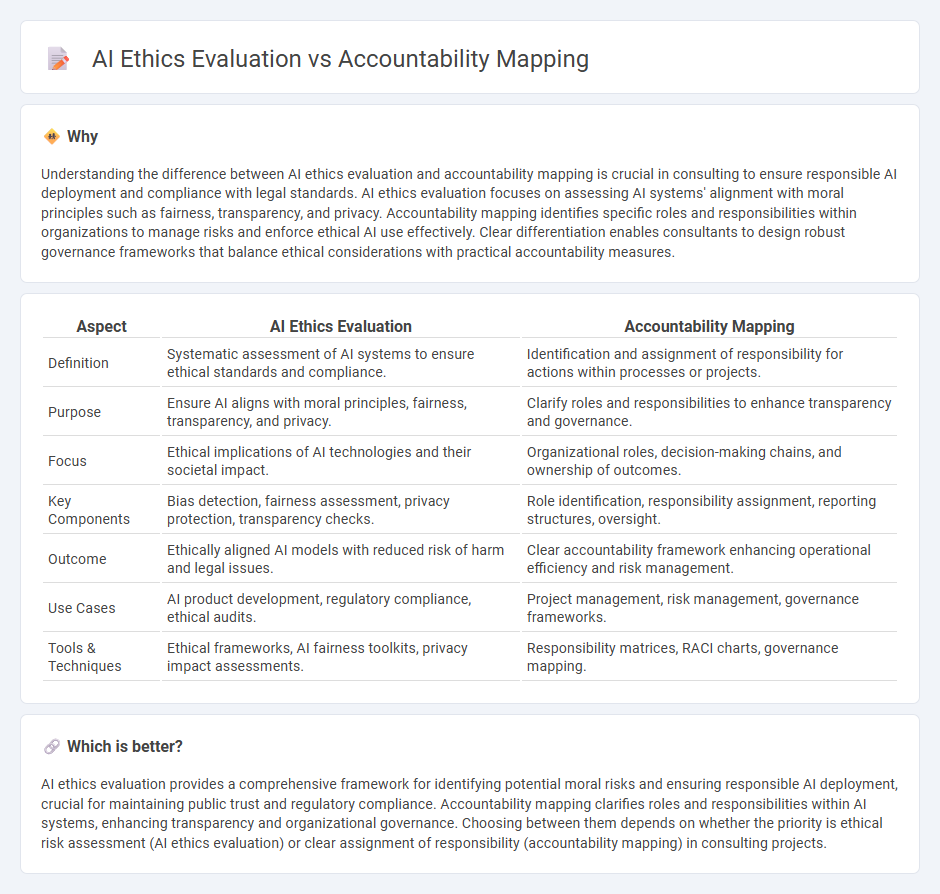
AI ethics evaluation focuses on assessing algorithms for fairness, transparency, and bias mitigation, ensuring responsible AI deployment aligned with societal values. Accountability mapping identifies duties and stakeholders responsible for AI systems, creating clear governance frameworks to manage risks and compliance. Explore the distinctions to implement ethical and accountable AI effectively.
Why it is important
Understanding the difference between AI ethics evaluation and accountability mapping is crucial in consulting to ensure responsible AI deployment and compliance with legal standards. AI ethics evaluation focuses on assessing AI systems' alignment with moral principles such as fairness, transparency, and privacy. Accountability mapping identifies specific roles and responsibilities within organizations to manage risks and enforce ethical AI use effectively. Clear differentiation enables consultants to design robust governance frameworks that balance ethical considerations with practical accountability measures.
Comparison Table
| Aspect | AI Ethics Evaluation | Accountability Mapping |
|---|---|---|
| Definition | Systematic assessment of AI systems to ensure ethical standards and compliance. | Identification and assignment of responsibility for actions within processes or projects. |
| Purpose | Ensure AI aligns with moral principles, fairness, transparency, and privacy. | Clarify roles and responsibilities to enhance transparency and governance. |
| Focus | Ethical implications of AI technologies and their societal impact. | Organizational roles, decision-making chains, and ownership of outcomes. |
| Key Components | Bias detection, fairness assessment, privacy protection, transparency checks. | Role identification, responsibility assignment, reporting structures, oversight. |
| Outcome | Ethically aligned AI models with reduced risk of harm and legal issues. | Clear accountability framework enhancing operational efficiency and risk management. |
| Use Cases | AI product development, regulatory compliance, ethical audits. | Project management, risk management, governance frameworks. |
| Tools & Techniques | Ethical frameworks, AI fairness toolkits, privacy impact assessments. | Responsibility matrices, RACI charts, governance mapping. |
Which is better?
AI ethics evaluation provides a comprehensive framework for identifying potential moral risks and ensuring responsible AI deployment, crucial for maintaining public trust and regulatory compliance. Accountability mapping clarifies roles and responsibilities within AI systems, enhancing transparency and organizational governance. Choosing between them depends on whether the priority is ethical risk assessment (AI ethics evaluation) or clear assignment of responsibility (accountability mapping) in consulting projects.
Connection
AI ethics evaluation and accountability mapping are interconnected through their shared goal of ensuring responsible AI deployment by identifying ethical risks and assigning clear responsibilities. Ethics evaluations analyze AI systems for fairness, transparency, and bias, while accountability mapping delineates roles and duties among stakeholders to address these ethical concerns effectively. This integrated approach supports compliance with regulatory frameworks and fosters trust in AI-driven solutions.
Key Terms
Accountability mapping:
Accountability mapping systematically identifies responsible parties and decision-makers throughout AI project lifecycles, enhancing transparency and governance in AI implementation. This method pinpoints specific roles and processes, ensuring clear attribution of responsibility for outcomes and ethical compliance. Explore accountability mapping techniques to strengthen ethical AI frameworks and promote responsible innovation.
Responsibility assignment
Accountability mapping involves systematically identifying and assigning clear responsibility for actions within AI development and deployment processes to ensure ethical standards are met. AI ethics evaluation focuses on assessing AI systems against ethical principles, highlighting moral implications, and identifying areas of potential harm or bias. Explore how integrating accountability mapping enhances the robustness of AI ethics evaluations to ensure responsible AI governance.
Stakeholder analysis
Accountability mapping systematically identifies and assigns responsibility across all parties involved, ensuring transparent governance in AI projects. AI ethics evaluation incorporates stakeholder analysis to assess potential biases, fairness, and impacts on diverse groups throughout the AI lifecycle. Explore more about integrating accountability mapping with AI ethics for comprehensive stakeholder-centric solutions.
Source and External Links
Creating an Employee Accountability Map - Functionly - An accountability map outlines organizational functions, roles, and responsibilities, helping identify gaps and ensure tasks are assigned properly for successful outcomes in a company.
Accountability Mapping - Provides coaching and workshops to transform personal and collective accountability through body-centered somatic coaching and transformative justice approaches.
Global Accountability Map - PIPD - An interactive map tracking accountability measures such as sanctions and divestments by states and organizations in a geopolitical context, excluding ongoing legal cases and position statements.
 dowidth.com
dowidth.com